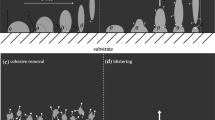Abstract
Effectiveness of lipase in detergency was studied using three test soils (lard, artificial sebum, and olive oil) on a woven cotton fabric. Distribution of oily soil on fabrics was determined for three different treatments (unwashed, washed with detergent without lipase, and washed with detergent plus lipase). Osmium tetroxide was used to label lipid soil for analysis in the scanning electron microscope. Both longitudinal and cross-sectional backscattered electron images for unwashed samples showed that soil was present on surfaces of the cotton fibers and in interfiber spaces of the yarn bundle. Lard soiled samples had large deposits on the fabric surfaces, while artificial sebum and olive oil appeared more uniformly distributed throughout the textile. Oil was deposited in the interfiber capillaries of the yarn bundle and in the crenulation, secondary walls, and lumen of the fibers. Energy dispersive X-ray microanalysis was used to determine relative concentrations of oil at selected morphological locations within the fiber structure and at the fiber surface. Soil distributions within the fibrous structures differed with type of soil and laundry treatment. Backscattered electron images dramatically demonstrated the effect of lipase on cleaning. After washing with detergent plus lipase, yarn surfaces had much less residual soil; residual soil that remained was in the irregularities of the cotton fiber surfaces. Concentrations of oil in the secondary walls, crenulations, lumen, and the fiber surfaces were lower after lipase treatment for all three soils. While washing with detergent removed soil from the yarn and fiber surfaces and the crenulation of the cotton fiber, only the samples washed with detergent plus lipase had lower concentrations of soils within the secondary wall and lumen of the cotton fibers. Fabrics soiled with olive oil and washed with detergent plus lipase had the lowest concentrations of residual soil across the textile structure; the residual soil observed was mainly in the irregularities on the fiber surfaces.
Similar content being viewed by others
References
Christensen, N.P., K. Thomsen, and S. Branner, Development of Detergent Enzymes, Proceedings of the 2nd World Conference on Detergents, Looking Towards the 90's, edited by A.R. Baldwin, AOCS Press, Champaign, 1987, p. 181.
Aaslyng, D., E. Gormsen, and H. Malmos, Mechanistic Studies of Proteases and Lipases for the Detergent Industry, J. Chem. Tech. Biotechnol. 50:321 (1991).
Fujji, T., T. Tatara, and M. Minagawa, Studies on Applications of Lipolytic Enzyme in Detergency I. Effect of Lipase from Candida cylindracae on Removal of Olive Oil from Cotton Fabric, J. Am. Oil Chem. Soc. 63:796 (1986).
Gormsen E., P. Rosholm, and M. Lykke, Enzymes for Laundry Products, Proceedings of the 3rd World Conference on Detergents: Global Perspectives, AOCS Press, Champaign, 1994, p. 198.
Obendorf, S.K., and N.A. Klemash, An Electron Microscopical Analysis of the Penetration of Oily Soil into Cotton and Polyester/Cotton Fabrics, Text. Res. J. 52:434 (1982).
Obendorf, S.K., Y.M.N. Namaste, and D.J. Durnam, A Microscopical Study of Residual Oily Soil Distribution on Fabrics of Varying Fiber Content, Ibid 53:375 (1983).
Obendorf, S.K., and J.J. Webb, Detergency Study: Distribution of Natural Soils on Shirt Collars, Ibid. 57:557 (1987).
Obendorf, S.K., Electron Microscopical Study of Soiling and Soil Removal, Text. Chem. Color. 20(5):11 (1988).
Chi, Y.-S., and S.K. Obendorf, Detergency of Used Motor Oil from Cotton and Polyester Fabrics, J. Surfact. Deterg. 2:1 (1999).
ASTM D 4265-93 Standard Guide for Evaluating Stain Removal Performance in Home Laundering, Annual Book of ASTM Standards, Vol. 15.04, ASTM, West Conshohocken, 1996.
Spence, J.T., J.W. Cotton, B.J. Underwood, and C.P. Duncan, Elementary Statistics, 4th edn., Prentice-Hall, Inc., Englewood Cliffs, 1983, pp. 215.
Kassenbeck, P., Bilateral Structure of Cotton Fibers as Revealed by Enzymatic Degradation, Text. Res. J. 40:330 (1970).
Weglinski, S.A., and S.K. Obendorf, Soil Distribution on Fabric After Laundering, Text. Chem. Color. 17:196 (1985).
Park, E.-K.C., and S.K. Obendorf, Chemical Changes in Unsaturated Oils upon Aging and Subsequent Effects on Soil Removal and Fabric Appearance, J. Am. Oil Chem. Soc. 71:17 (1994).
Webb, J.J., and S.K. Obendorf, Detergency Study: Comparison of the Distribution of Natural Residual Soils After Laundering with a Variety of Laundry Products, Text. Res. J. 57:640 (1987).
Dugan, L., Lipids, in Principles of Food Science Part I Food Chemistry, edited by O.R. Fennema, Marcel Dekker, New York, 1976, p. 139.
Scott, B.A., Mechanism of Fatty Soil Removal, J. Appl. Chem. 13:133 (1963).
Rowland, S.T., and N.R. Bertoniere, Chemical Methods of Studying Supramolecular Structure, in Cellulose Chemistry and Its Applications, edited by T.P. Nevell and S.H. Zeronian, John Wiley & Sons, New York, 1985, p. 112.
Author information
Authors and Affiliations
Corresponding author
About this article
Cite this article
Varanasi, A., Obendorf, S.K., Pedersen, L.S. et al. Lipid distribution on textiles in relation to washing with lipases. J Surfact Deterg 4, 135–146 (2001). https://doi.org/10.1007/s11743-001-0166-4
Received:
Accepted:
Issue Date:
DOI: https://doi.org/10.1007/s11743-001-0166-4




